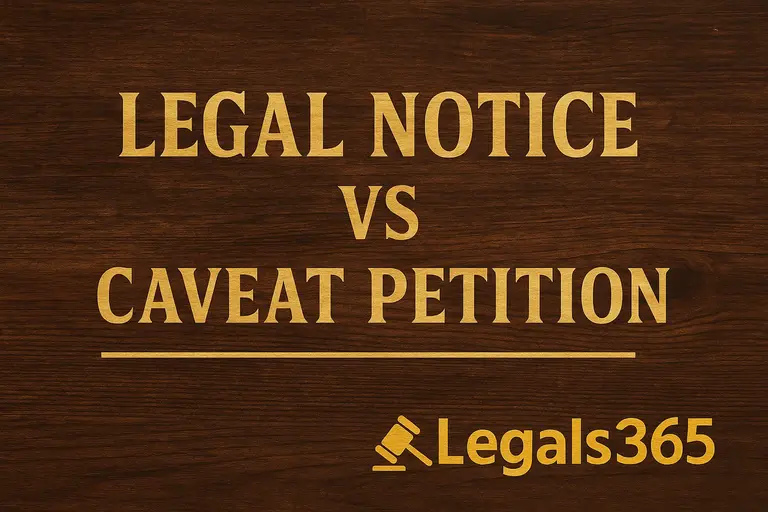
Understanding the Difference Between Caveat Petitions and Legal Notices
Introduction
When people hear the words “caveat petition” and “legal notice,” many think they’re the same. But in practice, these two legal tools serve completely opposite purposes. One protects you from being caught off guard in court, and the other is a formal warning you send when someone else is at fault.
At Legals365, we often explain this distinction to clients involved in property matters, family disputes, or business issues. Here’s a clear, no-jargon explanation to help you understand which document is right for your situation—and why timing matters.
What is a Caveat Petition?
A caveat petition is like giving the court a heads-up. It’s filed when you believe someone may file a case against you and try to get an order without your side being heard.
Think of it this way: You’re saying to the court, “Before anything is decided about me, I want a chance to speak.”
When Should You File It?
Say you and a relative are arguing over a house. You think they might try to get a stay order to stop you from selling it. If you file a caveat, the court has to inform you if they file anything—so you can defend yourself before any decision is made.
What the Law Says
This right comes from Section 148A of the Civil Procedure Code, 1908. It’s a safeguard to stop one-sided court orders in civil matters.
Key Details Included in a Caveat:
- The name of the court
- Your name and address (you’re the caveator)
- Name of the person likely to file a case
- What kind of application you expect them to file
- An address where you can be notified
Time Limit
Once submitted, a caveat stays valid for 90 days. If nothing happens during that time, you’ll need to refile to stay protected.
What is a Legal Notice?
A legal notice is different. Instead of filing it in court, you send it directly to the other party—usually through a lawyer. It’s a formal way to say, “There’s a problem. Fix it or I’ll take legal action.”
When Should You Send It?
Imagine your tenant hasn’t paid rent in two months. Or a contractor walked away halfway through the job. Rather than going straight to court, you send a legal notice. It lays out your complaint, asks for a solution, and gives a deadline to respond.
What’s Typically in a Legal Notice?
- Contact information of both sides
- A summary of the facts or dispute
- A demand—whether it’s money, possession, or performance
- A clear time frame to reply (often 15–30 days)
- A statement that legal action will follow if ignored
Is It Required by Law?
Yes—sometimes. If you’re planning to sue a government office or agency, the law says you must send a legal notice first under Section 80 of the CPC.
Caveat vs Legal Notice: What’s the Difference?
Let’s break this down side by side:
| Feature | Caveat Petition | Legal Notice |
|---|---|---|
| Filed By | Person anticipating legal action | Person planning to initiate legal action |
| Filed With | The court | Sent to the opposite party |
| Purpose | To ensure fair hearing before any order | To warn or demand relief before suing |
| Time Validity | 90 days | Depends on response deadline |
| Legal Provision | Section 148A CPC | Section 80 CPC (for govt. cases) |
| Role | Defensive | Proactive and assertive |
Real-Life Examples from Our Clients
🔸 A builder in Noida expected a legal dispute with a co-partner over project funds. He came to us at Legals365, and we filed a caveat petition for him. Two weeks later, the co-partner filed a plea. Thanks to the caveat, our client was informed and responded in time. No ex-parte order was passed.
🔸 Another client, a small business owner, hadn’t been paid by a supplier. Instead of rushing to court, we helped draft a legal notice. The supplier responded, settled the dues, and both sides avoided a court case altogether.
Why Getting It Right Matters
Using the wrong legal tool can waste time, confuse the court, or even damage your case.
If you’re expecting legal trouble—file a caveat.
If you’re ready to confront someone for a loss or breach—send a legal notice.
It’s not about reacting. It’s about acting smartly, with the right document at the right moment.
How Legals365 Supports You
Whether you’re defending yourself or asserting your rights, Legals365 gives you practical legal support every step of the way.
What We Do:
- Help you decide between a caveat or a legal notice
- Draft and file court-ready caveat petitions
- Prepare legal notices that get noticed—and taken seriously
- Deliver notices via RPAD, courier, or email
- Represent you if the matter escalates
Led by Advocate B.K. Singh, we offer pan-India support with offices and digital consultation available through OnlineNoida.
Final Thoughts
Legal tools like caveats and notices aren’t just paperwork—they’re strategy.
Used correctly, a caveat protects your voice in court. A legal notice, when sent at the right time, can resolve a matter before it becomes a full legal battle.
At Legals365 and Online Noida, we don’t just file forms we help you make informed legal choices. If you’re not sure what the next step is, we’ll help you figure it out.
#CaveatPetitionIndia #LegalNoticeIndia #IndianCivilLaw #AdvocateBKSingh #Legals365 #SendLegalNotice #FileCaveat #Section148A #Section80CPC #NoidaLawyer #LegalSupportIndia #CivilDisputes #OnlineNoidaLegalHelp #LawFirmsDelhiNCR #CourtProtectionTools
